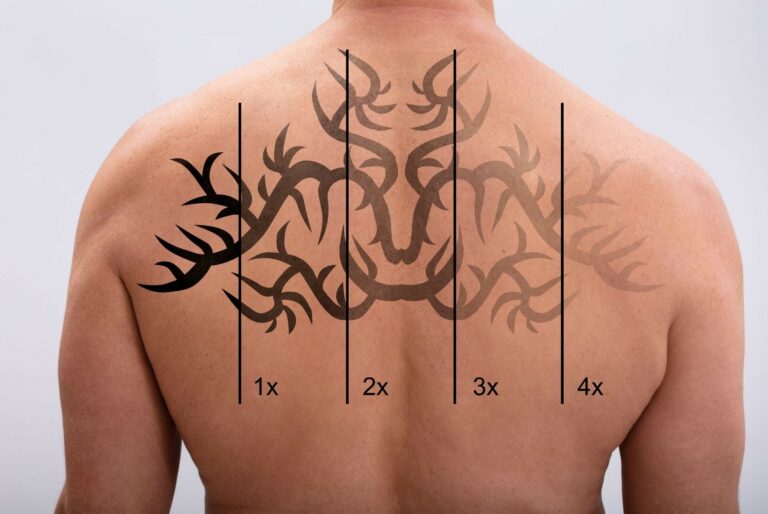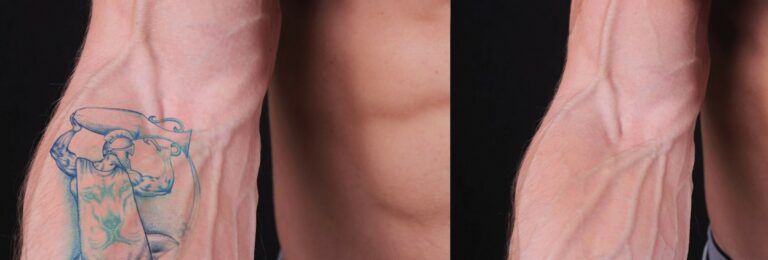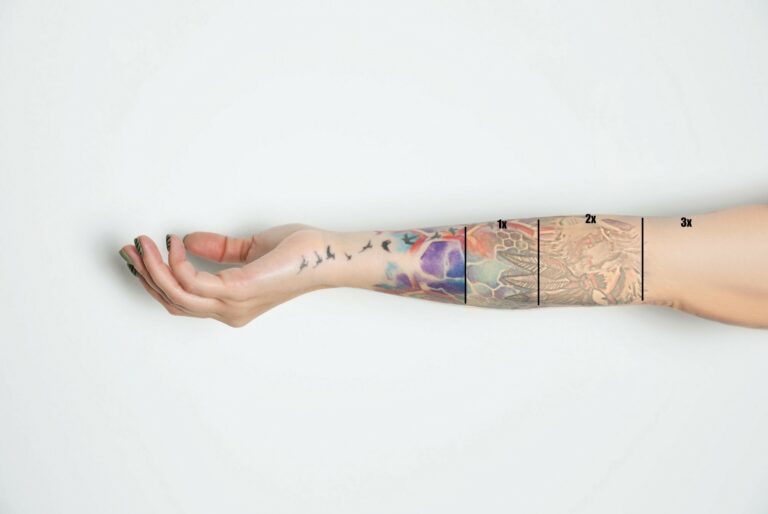Tattoo Removal Consultation and Evaluation
Tattoo removal is a process that involves the use of laser technology to break up the ink particles in a tattoo so that they can be removed by the body’s natural immune system. While tattoo removal has become increasingly popular in recent years, it is important to understand that the process can be quite involved and requires careful consideration before undergoing treatment.
this article deals with Tattoo Removal Consultation and Evaluation
Brief Overview of the Tattoo Removal Process
The process of tattoo removal typically involves a series of sessions, during which laser energy is directed at the ink in the skin. The energy breaks up the ink particles into smaller pieces, which are then absorbed into the body and eliminated through natural processes. The number of sessions required depends on several factors, including the size and color(s) of the tattoo, as well as its location on the body.
While some tattoos can be fully removed with only a few sessions, others may require more treatments over a longer period of time. It is important to note that complete removal may not always be possible, particularly for tattoos with certain colors (such as green or blue) or those located on areas with thinner skin-like fingers.
Importance of Tattoo Removal Consultation and Evaluation Before Undergoing Tattoo Removal

The decision to undergo tattoo removal should not be taken lightly. Before beginning treatment, it is crucial to schedule a consultation with an experienced specialist who can provide customized advice based on your individual needs and situation.
A thorough evaluation will allow your specialist to create a tailored treatment plan that takes into account factors such as your age, skin type, medical history, and overall health. Additionally, this consultation will give you an opportunity to ask questions about what to expect during treatment sessions and discuss any concerns you might have beforehand. So it’s very important to find a reliable specialist who will guide you through this process keeping all aspects in view.
Ultimately, the goal of consultation and evaluation is to ensure that you are fully informed about the process and outcomes of tattoo removal so that you can make an informed decision about whether it is right for you. With the help of a skilled specialist, you can feel confident that your treatment plan will be designed with your unique needs in mind, making the process smoother and faster.
While tattoo removal can be a complex process, taking these initial steps to consult with a specialist beforehand will help set realistic expectations, minimize potential complications, and ultimately lead to better outcomes. So take your time to find the right professional and have an open conversation about your goals & motivations for tattoo removal.
Consultation with a Tattoo Removal Specialist
Finding a reputable tattoo removal specialist
Before undergoing any medical procedure, it is important to find a specialist who is qualified and experienced in the field. When it comes to tattoo removal, finding a reputable specialist is crucial for achieving optimal results while minimizing risks and complications. To find the best specialist for your needs, start by doing research online and looking for reviews or testimonials from previous patients.
You can also ask for recommendations from friends or family members who have undergone similar procedures. It’s important to ensure that the specialist you choose is licensed and certified in tattoo removal specifically.
You can check their credentials by visiting their website or contacting their practice directly. A good specialist will have undergone specialized training and will be able to provide you with proof of certification.
Scheduling a consultation appointment
Once you have found a few potential specialists, it’s time to schedule an initial consultation appointment. This appointment typically lasts between 30 minutes to an hour and provides an opportunity for the patient and specialist to discuss the procedure in detail.
During this consultation, you should expect to provide information about your medical history as well as details about your tattoo(s). The specialist will assess your skin type, evaluate the tattoo(s) you want removed, and recommend specific treatment options based on his/her findings.
Discussing expectations and concerns with the specialist
It’s important that both you and your chosen specialist are on the same page when it comes to expectations surrounding your treatment plan. During your consultation, make sure that you explain clearly what kind of results you are hoping for from removing your tattoos. The specialist will be able to tell you if these expectations are realistic or not based on his/her findings during the evaluation.
This initial meeting is also a good time for discussing any concerns or questions that might be weighing on your mind before starting the procedure. Asking as many questions as possible can help alleviate any fears or uncertainties you might have about the process and put your mind at ease.
Choosing the right specialist for you
Ultimately, choosing the right specialist for tattoo removal comes down to finding someone who is experienced, knowledgeable, and trustworthy. You want a specialist who will provide honest recommendations and ensure that your goals are achievable within a realistic time frame. It’s important not to rush into making a decision based on price alone.
While it’s understandable to want to save money, choosing a less expensive option could end up costing you more in the long run if complications arise or results are unsatisfactory. Take the time to research several specialists before making your final decision.
The importance of building trust with your specialist
Building trust with your tattoo removal specialist is key to ensuring a successful outcome and a good experience overall. When you feel comfortable with your chosen specialist, you are more likely to communicate openly about concerns or potential complications that may arise during treatment.
Having open communication can also make the process less stressful overall as it helps create realistic expectations about what can be achieved and how long it may take. Next section: Evaluation of the Tattoo to be Removed
Evaluation of the Tattoo to be Removed
Examining the size, location, and color(s) of the tattoo
One of the first things a tattoo removal specialist will evaluate is the size, location, and color(s) of your tattoo. The size and location play a role in determining how many sessions it will take to remove the tattoo completely. Large tattoos or tattoos located on areas with thick skin (such as the arms or legs) may require more sessions than smaller tattoos or tattoos on thinner skin (such as the neck or wrist).
The colors of your tattoo also play a role in determining how easily it can be removed. Black ink is typically easier to remove than colored ink.
Assessing the depth and density of ink in the skin
Another important aspect of evaluating a tattoo for removal is assessing its depth and density in the skin. Older tattoos tend to have deeper ink penetration into multiple layers of skin which make them harder to remove than newer ones that have been applied closer to the surface.
This can also cause more pain during treatment in some cases. Additionally, dense shading or bold lines can make it more difficult for lasers to penetrate through all layers of ink during treatment which again could mean additional treatments are needed for complete removal.
Identifying any potential complications or risks
When evaluating a patient’s suitability for laser-based tattoo removal treatments, potential complications need to be identified prior to initiating any procedure. Some potential complications include a change in pigmentation at site, allergic reactions (to pigment particles from breakdown), burns (due to overheating), scarring, etc.
The presence of pre-existing medical conditions such as diabetes or autoimmune disorders may also increase risks associated with laser therapy as well. It is important that you discuss with your specialist your medical history so they can identify any potential risk factors before starting treatment.
The Factors of a Particular Tattoo That Influence its Difficulty to Remove
– The age of the tattoo: The older the tattoo, the more difficult it is to remove. This is due to the ink penetrating deeper into the skin over time.
– The location of the tattoo: Tattoos located on areas with more fat and thicker skin (such as arms or legs) tend to be harder to remove than tattoos located on thinner areas like the neck or wrist. – The colors in the tattoo: Black ink is typically easier to remove than colored ink, though this can vary depending on how deep and dense it has been applied.
– The density of shading in the tattoo: Tattoos with dense shading may require more treatment sessions as they have a greater volume of ink per square millimeter. – Skin type: Individuals with darker skin tones may experience more difficulty in the removal process due to a greater likelihood of changes in pigmentation.
To summarize
Having a thorough evaluation is an essential part of preparing for laser-based tattoo removal. Assessing your tattoo’s size, color, and depth and locating potential complications or risks can help specialists create an individualized plan that will help you achieve the best possible results after completing the necessary number of sessions. Knowing which factors influence how difficult it will be for your specific case is also equally important so you know what to expect from treatment sessions and the recovery process.
Health Assessment
When preparing for tattoo removal, it is important for the specialist to conduct a thorough health assessment. This is because factors such as medical history, medications, and health conditions can all impact the effectiveness of treatment and increase the risk of complications.
Reviewing Medical History
One of the first things a specialist will do during a health assessment is review your medical history. This includes any existing medical conditions you may have, as well as any medications you are currently taking or have taken in the past.
Certain medical conditions, such as diabetes or autoimmune disorders, can make tattoo removal more difficult or increase the risk of adverse effects. In addition, certain medications can also affect treatment – for example, blood thinners can cause excessive bleeding during treatment.
Discussing Any Medications or Health Conditions That Could Affect Treatment
It is essential that you inform your tattoo removal specialist about any medications you are currently taking or have taken in the past. This includes prescription drugs, over-the-counter medicines such as pain relievers, or supplements like vitamins. Certain medications may need to be paused prior to your tattoo removal appointment in order to minimize side effects and ensure optimal results.
In addition to medication use and medical history review, it’s important to discuss any allergies you may have with your specialist. If they know about your allergies beforehand they can avoid using anything that could trigger a reaction during treatment.
Performing A Skin Sensitivity Test
In some cases, a skin sensitivity test may be conducted during a consultation appointment before proceeding with actual laser treatment. This involves applying low-intensity laser energy to a small area of skin near the tattoo site in order to assess how well your skin reacts and determine what power settings will deliver safe yet effective results.
The test involves applying different wavelengths on different parts of the skin at 24-48 hour intervals and observing the area for any adverse reactions. If there are any complications during the skin sensitivity test, such as blistering or severe redness, it may indicate that you are not a good candidate for laser tattoo removal.
Overall, performing a thorough health assessment is essential in ensuring safe and effective tattoo removal. Through reviewing medical history, discussing medication use and health conditions that could affect treatment, and performing a skin sensitivity test when necessary, your specialist can create an individualized treatment plan that takes into account your unique needs and minimizes risks. Be sure to disclose all relevant information to your specialist so they can help you achieve the best possible results with minimal risk of side effects or complications.
Treatment Plan Development
After the consultation and evaluation, the tattoo removal specialist will devise a customized treatment plan that is specific to your individual needs. The treatment plan will be based on several factors including the size, location, density, and color(s) of the tattoo.
It is important to note that every tattoo is unique and therefore requires a tailored approach. The specialist will also advise you on how many sessions are required for the complete removal of your tattoo.
Generally, multiple sessions are necessary for effective removal as tattoos have several layers of ink embedded in the skin. The number of sessions needed depends on various factors such as the age of the tattoo, type of ink used, and location among others.
During this stage, it is crucial to ask any questions or raise concerns with your specialist so that they can further explain their proposed treatment plan. This way you can both agree on a course of action and know what to expect during each session.
The Number Of Sessions Required
As previously mentioned, multiple treatments are necessary for complete removal. Most patients require between 6-8 treatments but more may be required depending on various factors such as density or depth of ink used in the tattoo.
The interval between treatments depends on skin sensitivity as well as how quickly your body’s immune system can remove ink particles from treated areas which differs from person to person. Typically treatments are spaced 6-8 weeks apart to allow adequate time for skin recovery between sessions.
What To Expect During Each Session
The actual process during each session may vary slightly depending on the type of laser being used by your specialist. However here are some general steps you should expect:
- A topical numbing agent will be applied to the area being treated prior to starting off with the procedure. This will help to minimize any discomfort or pain felt during the procedure.
- The laser is then positioned over the tattooed area and activated, sending a high-intensity beam of light that breaks up the ink in your skin.
- You may feel some mild discomfort during this process but generally tolerable.
- After each session, an ice pack may be applied to your skin to reduce swelling and soothe any discomfort you might feel in the treated area.
It’s important to remember that following these sessions you must take care of your skin as per the specialist’s advice. Without proper after-care, there is an increased risk of complications such as infection or scarring which can make it difficult for further treatment sessions. Developing a personalized treatment plan is critical in ensuring successful tattoo removal.
It allows for a tailored approach that takes into account all the unique factors of each individual tattoo making it possible for effective removal through a series of treatments. The number of treatments required depends on several factors including age, color density, and location among others.
Preparing for Treatment
Following Pre-Treatment Instructions
After the consultation and evaluation, your tattoo removal specialist will provide you with pre-treatment instructions. These instructions are essential to prepare your tattoo and skin for the removal process. It is crucial to follow these instructions carefully for optimal treatment results.
Your specialist may advise you to avoid sun exposure, not use certain skincare products, or shave the area surrounding the tattoo before treatment. It is crucial to adhere to these recommendations as they can affect treatment outcomes.
One of the most important pre-treatment instructions is avoiding sun exposure. Exposure to UV rays can cause skin damage and negatively impact laser treatment results.
Therefore, it is essential always to wear protective clothing when going outside and use broad-spectrum sunscreen with an SPF of 30 or higher on the treatment area. Your tattoo removal specialist may also recommend avoiding certain skincare products like retinol or alpha-hydroxy acids that can increase skin sensitivity before treatment sessions.
Taking Care of Your Skin
In addition to following pre-treatment instructions, it is vital to take care of your skin after each session by keeping it moisturized, hydrated, and healthy. Moisturizing your skin can help minimize potential side effects such as dryness or itchiness after each session. You should apply a gentle moisturizer daily without rubbing it into your skin aggressively.
Drinking plenty of water also helps keep your skin hydrated from within. Staying hydrated keeps your body in good condition and promotes faster healing processes between sessions.
Maintaining healthy habits such as eating fruits and vegetables rich in vitamins A & C can improve the health of your skin significantly. Preparing for tattoo removal involves following pre-treatment advice provided by specialists and taking care of your body’s largest organ by keeping it moisturized, hydrated, and healthy.
Key Takeaways
After reading this article, it should be clear that proper consultation and evaluation are crucial before undergoing tattoo removal. This process ensures that the treatment plan is customized to your unique needs and helps minimize the risk of complications or unsatisfactory results.
By taking the time to find a reputable specialist, assessing the tattoo to be removed, evaluating your health, and preparing for treatment appropriately, you can increase the chances of achieving successful removal with minimal side effects. Overall, the importance of a thorough consultation with a tattoo removal specialist cannot be overstated.
Not only will they help you understand what to expect during each session and provide instructions on how to prepare for treatment, but they can also identify any underlying medical conditions or other factors that may affect your ability to undergo tattoo removal safely. This can include skin sensitivity issues, allergies to certain products or medications, or other underlying health concerns that could make tattoo removal more difficult.
Additionally, evaluating the tattoo itself is crucial in determining a suitable treatment plan. Factors such as size and location on the body play a significant role in how easily it can be removed.
The density and depth of ink in the skin also determine how challenging it will be to remove completely. By following any pre-treatment instructions provided by your specialist and taking care of your skin leading up to each session (such as keeping it moisturized), you can optimize your chances for success.
While tattoo removal may seem like an easy solution for unwanted body art at first glance- proper preparation is key. Consultation with a reputable specialist who evaluates both the client’s physical health status as well as their unique artwork situation allows them insight into creating appropriate strategies towards success throughout this journey – which ultimately leads towards happy endings!
references
Tattoo removal by non-professionals–medical and forensic considerations – PubMed (nih.gov)
Regrets after tattooing and tattoo removal in the general population of France – PubMed (nih.gov)
Self-reported Patient Motivations for Seeking Cosmetic Procedures – PubMed (nih.gov)
Medical Disclaimer:
The information provided on this website regarding tattoo removal techniques is for general informational purposes only. It is not intended to be a substitute for professional medical advice, diagnosis, or treatment. Always seek the advice of a qualified healthcare professional regarding any medical condition or concerns, including tattoo removal.
The content presented on this website should not be interpreted as endorsing or promoting any specific tattoo removal technique, product, or service. The effectiveness, safety, and suitability of tattoo removal methods can vary depending on individual circumstances and factors. Therefore, it is crucial to consult with a medical professional or qualified specialist before making any decisions or embarking on any tattoo removal procedure.
The website does not guarantee the accuracy, completeness, or reliability of the information provided. Reliance on any information from this website is solely at your own risk. The website and its owners, authors, and contributors shall not be held liable for any damages or consequences arising from the use of the information provided.
It is important to note that medical practices and standards may change over time, and the information provided on this website may not always reflect the most up-to-date research or guidelines. Therefore, it is recommended to consult with healthcare professionals or reputable sources for the latest information and advice on tattoo removal techniques.
If you experience any adverse reactions, complications, or concerns during or after a tattoo removal procedure, promptly seek medical attention. Only a qualified healthcare professional can assess your specific situation and provide appropriate advice and treatment.
By using this website, you acknowledge and agree to the above disclaimer, and you understand that the website and its owners, authors, and contributors cannot be held responsible for any decisions or actions taken based on the information provided.




